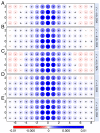Intertwined spin, charge, and pair correlations in the two-dimensional Hubbard model in the thermodynamic limit
- PMID: 35140180
- PMCID: PMC8851552
- DOI: 10.1073/pnas.2112806119
Intertwined spin, charge, and pair correlations in the two-dimensional Hubbard model in the thermodynamic limit
Abstract
The high-temperature superconducting cuprates are governed by intertwined spin, charge, and superconducting orders. While various state-of-the-art numerical methods have demonstrated that these phases also manifest themselves in doped Hubbard models, they differ on which is the actual ground state. Finite-cluster methods typically indicate that stripe order dominates, while embedded quantum-cluster methods, which access the thermodynamic limit by treating long-range correlations with a dynamical mean field, conclude that superconductivity does. Here, we report the observation of fluctuating spin and charge stripes in the doped single-band Hubbard model using a quantum Monte Carlo dynamical cluster approximation (DCA) method. By resolving both the fluctuating spin and charge orders using DCA, we demonstrate that they survive in the doped Hubbard model in the thermodynamic limit. This discovery also provides an opportunity to study the influence of fluctuating stripe correlations on the model's pairing correlations within a unified numerical framework. Using this approach, we also find evidence for pair-density-wave correlations whose strength is correlated with that of the stripes.
Keywords: Hubbard model; dynamical cluster approximation; stripe.
Copyright © 2022 the Author(s). Published by PNAS.
Conflict of interest statement
The authors declare no competing interest.
Figures





References
-
- Fradkin E., Kivelson S. A., Tranquada J. M., Colloquium: Theory of intertwined orders in high temperature superconductors. Rev. Mod. Phys. 87, 457–482 (2015).
-
- Tranquada J. M., Sternlieb B. J., Axe J. D., Nakamura Y., Uchida S., Evidence for stripe correlations of spins and holes in copper oxide superconductors. Nature 375, 561–563 (1995).
-
- Agterberg D. F., et al. ., The physics of pair-density waves: Cuprate superconductors and beyond. Annu. Rev. Condens. Matter Phys. 11, 231–270 (2020).
-
- Tranquada J. M., Cuprate superconductors as viewed through a striped lens. Adv. Phys. 69, 437–509 (2021).
-
- Qin M., et al. ., Absence of superconductivity in the pure two-dimensional Hubbard model. Phys. Rev. X 10, 031016 (2020).
LinkOut - more resources
Full Text Sources

